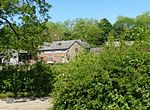Astley Green Colliery
AC with 0 elementsCoal mines in LancashirePages containing links to subscription-only contentUnderground mines in England

Astley Green Colliery was a coal mine in Astley, Greater Manchester, then in the historic county of Lancashire, England. It was the last colliery to be sunk in Astley. Sinking commenced in 1908 by the Pilkington Colliery Company, a subsidiary of the Clifton and Kersley Coal Company, at the southern edge of the Manchester Coalfield, working the Middle Coal Measures where they dipped under the Permian age rocks under Chat Moss. The colliery was north of the Bridgewater Canal. In 1929 it became part of Manchester Collieries, and in 1947 was nationalised and integrated into the National Coal Board. It closed in 1970, and is now Astley Green Colliery Museum.
Excerpt from the Wikipedia article Astley Green Colliery (License: CC BY-SA 3.0, Authors, Images).Astley Green Colliery
Whitehead Lane,
Geographical coordinates (GPS) Address Website Nearby Places Show on map
Geographical coordinates (GPS)
| Latitude | Longitude |
|---|---|
| N 53.495 ° | E -2.447 ° |
Address
Lancashire Mining Museum
Whitehead Lane
M29 7JB
England, United Kingdom
Open on Google Maps







